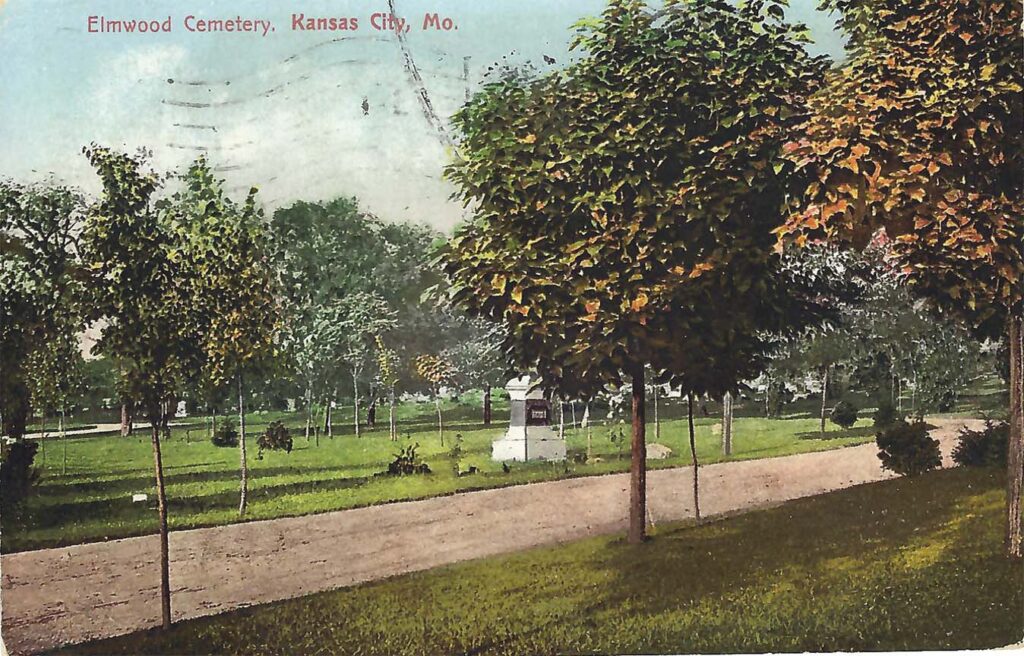
Michael Bushnell
Publisher
Welcome to the first of a series of four Historic Postcard columns dedicated to Elmwood Cemetery in honor of their sesquicentennial on October 1st.
When consecrated in 1872, Elmwood Cemetery at 4900 Truman Road was outside the city limits of Kansas City, located on part of a farm owned by Judge Lucius Cary. Named for the numerous Elm trees that were part of the landscape, it was the city’s fourth cemetery to be plotted and developed.
City Cemetery was located near Independence Avenue between Oak Street and Locust was the first, platted in 1838. Considered a public burial ground, it held some of the city’s earliest pioneers including William Miles Chick, one of the first permanent residents of the city and the city’s first Postmaster.
Another small, Catholic cemetery was located near Father Bernard Donnely’s Parish at 11th and Broadway and Union Cemetery, chartered in 1857 at 28th and Warwick Boulevard, named for its location halfway between the Town of Kansas and the city of West Port.
In 1897, George Kessler was hired to design a park-like setting for Elmwood, offering a less morbid setting to honor the city’s deceased. Kessler’s design followed a European movement toward a more enlightening view of death, creating a place for families to spend time together, often taking in a picnic while remembering their loved ones with pride for who they were and what they meant during their time.
Elmwood’s burial vaults and crypts are an excellent example of funerary art during the Victorian period. Taking full advantage of Kessler’s landscape design and the hilly topography, burial vaults bearing the names of some of Kansas City’s earliest and most prominent families line the shaded roadways that wind through Elmwood, bearing names such as Coates, Loose, former Mayor Elijah McGee and Kirkland Armour, meat packing baron and namesake of the Armour Chapel located in the heart of the cemetery.
From the very beginning, Elmwood Cemetery has been integrated on all fronts, welcoming burials of Africans Americans, Catholics and Protestants. Temple B’Nai Jehudah purchased two acres of the cemetery shortly after its opening for Jewish burials. It is considered the oldest Jewish burial ground in the city. Another portion of the cemetery is dedicated to those, both Blue and Grey who fought in the American Civil War, including a few who rode with William Clark Quantrill between 1858 and 1865.
One of Elmwood’s final burials was in April, 2019 when the remains of ten-month old Emma Huling were laid to rest in the family mausoleum for the second and hopefully final time. Huling, who died in 1865 was buried in Elmwood shortly after her death. Her remains were stolen earlier in 2019 but thieves were unable to open the cast-iron casket and abandoned Emma in a nearby bush. Her casket was discovered by Elmwood employees and the community rallied to purchase a new, infant sized casket and held a full funeral service in the Armour Chapel, complete with a bagpiper and printed programs. Emma Huling was re-interred back with her family with full honors on April 27th, 2019.
In 1983, Elmwood Cemetery was placed on the National Register of Historic Places due to its historical significance in Kansas City’s History. Over the next four weeks, we’ll tell the story of some of Elmwood’s over 31,000 residents as well as how the City Beautiful Movement that was sweeping the nation in the late 1890’s led to Landscape Architect George Kessler accepting the commission to design the Elmwood we see today. Our own Dorri Partain will also be offering profiles of some of Elmwood’s residents, some who rose to regional and national prominence, others who may not have had two nickels to rub together.
On Saturday, October 1st, Elmwood will host a 150th anniversary celebration. Check our website or the new Elmwood Cemetery web site at elmwoodcemeterykc.org.



















